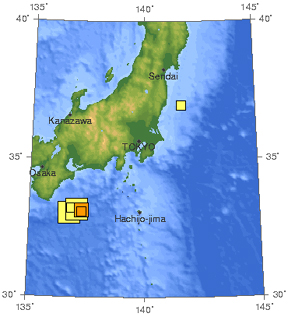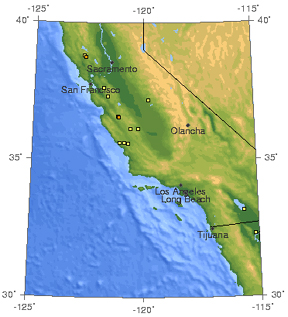Geotimes

Untitled Document

Web Extra
Tuesday, September 7, 2004
Botched earthquake prediction
 

Several large earthquakes struck south
of the Japanese island of Honshu on Sept. 5 and the two days following.
Researchers had predicted that a large earthquake would have hit southern
California that day, but the only earthquake of note was a magnitude-2.5
temblor at the south end of the Salton Sea in the San Andreas Fault zone.
The maps here show all earthquakes in the two regions in the past seven
days, as of the afternoon of Sept. 7. Images courtesy of the U.S. Geological
Survey Earthquake Hazards Program. |
Several large earthquakes struck Japan's central island of Honshu this weekend.
Had these events occurred on the other side of the Pacific "Ring of Fire,"
they would have fulfilled a forecast by a team of seismologists that a large
temblor would strike before Sept. 5 in Southern California.
Vladimir Keilis-Borok and his co-workers have been developing models for the past
30 years that they hope could predict earthquakes with some assurance (see
Geotimes, March 2004). Using databases covering several decades that
catalog a variety of factors, including timing and magnitude among others, the
team's algorithms cover California, Sumatra and elsewhere. As part of their testing,
the modelers have published forecasts in the literature.
Two successes that the team claims are the San Simeon earthquake in Paso Robles,
Calif., last December and a magnitude-8.1 earthquake that struck Hokkaido, Japan,
last year on Sept. 25 (the Japanese government also claimed success in forecasting
that earthquake).
Keilis-Borok and colleagues' September deduction is only one of many that has
had a null result. Nevertheless, Keilis-Borok remains optimistic. "Any
earthquake prediction algorithm must perform when applied to earthquakes. Our
team always expected from the start that some of our predictions would be false
alarms; we are also confident that many will be correct," he said in a
statement released by the University of California at Los Angeles, where the
international team conducts its work.
The most recent Japan earthquakes — a magnitude 7.0 at almost 20-kilometers
depth followed by two of magnitude 7.1 and 6.3, according to the U.S. Geological
Survey's Earthquake Hazards Program Web site — injured
more than 40 people, according to Reuters. The first two
earthquakes also triggered local tsunamis, half a meter to a meter tall. The Japanese
government had its own forecast standing for a major earthquake to strike central
Japan, of magnitude 8, offshore of Honshu but farther to the northeast. The epicenters
of this weekend's major earthquakes were over 100 kilometers offshore to the south
of the island. According to CNN.com, residents of Owase took
shelter from more possible tsunamis from predicted aftershocks that might occur
in the next week. No deaths were reported.
In the meantime, Keilis-Borok and his co-workers will use this latest result
to further improve their models. "We will learn from our mistakes how to
improve the prediction methodology. That is what scientific experiments are
for," he said. "If we made no mistakes, it would mean the problem
is easy; and it is not easy, to put it mildly."
Naomi Lubick
Links:
"Seismic
premonitions," Geotimes,
March 2004
"Earthquake
warning tools," Josh Chamot, Geotimes, October 2003
Earthquake
Hazards Program Web site (Asia region)
Reuters
UK reporting (link may no longer be valid after a certain date)
CNN.com
reporting (link may no longer be valid after a certain date)
Back to top
Untitled Document




